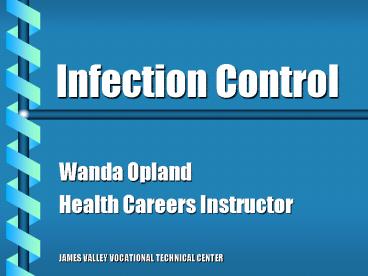Infection Control - PowerPoint PPT Presentation
1 / 25
Title:
Infection Control
Description:
Define, pronounce, and spell the key terms. Differentiate between antisepsis, ... Bacteriostatic solutions: slow or stops the growth of microorganisms ... – PowerPoint PPT presentation
Number of Views:32
Avg rating:3.0/5.0
Title: Infection Control
1
Infection Control
- Wanda Opland
- Health Careers Instructor
- JAMES VALLEY VOCATIONAL TECHNICAL CENTER
2
Objectives
- Define, pronounce, and spell the key terms
- Differentiate between antisepsis, disinfection,
and sterilization - Demonstrate aseptic hand washing
- Demonstrate how to don and remove an isolation
mask, gloves, and gown - Identify the five ways microorganisms are spread
of infection
3
- Define OSHA and explain the agencys role in
safety - List conditions which enhance growth of
microorganisms
4
Microorganisms
- Organisms which can only be seen by a microscope
- To Live
- Warm temperature
- moisture
- darkness
5
- Anaerobic
- microorganisms which live in an environment
without oxygen - Aerobic
- microorganisms which needs oxygen to live
6
- Nonpathogenic
- a microorganism that does not cause disease
- Pathogenic
- a microorganism which is disease producing
7
Pathogenic Microorganisms
- Bacteria
- can be treated with antibiotics
- Viruses
- smaller than bacteria
- cannot be treated with bacteria
8
Pathogenic Microorganisms
- Protozoa
- larger than virus, grow within host cell
- Fungi
- low form of plant life, includes mold yeast
9
Pathogen and disease
- Toxins
- some microorganisms produce poisons (toxins) that
affect the body
10
How Microorganisms Spread
- Direct Contact
- transmitted directly from one person to another
- Indirect contact
- transferred from one object to another
11
How Microorganisms Spread
- Airborne
- carried in the air
- Oral route
- enters body through water, food dirty hands
- Insects and Pests
- picked up on insects and pests and transferred
12
Signs and Symptoms
- Generalized
- involves the entire body
- Localized
- involves a single site
13
Asepsis
- Asepsis
- free from or keeping away disease producing
microorganisms - Medical Asepsis
- to destroy the environment that allows pathogens
to live, breed, and spread - Aseptic technique
- methods used to make the environment, worker,
and as germ free as possible
14
Aseptic Techniques to prevent spread of disease
- Cross infection
- caused by infecting the patient with a new
microorganism from another patient or health care
worker - Reinfection
- infection with the same microorganism that caused
the original illness
15
Aseptic Techniques to prevent spread of disease
- Self-innoculation
- infection by the patients own organisms
- An illness passing from the patient to the health
care worker or from worker to patient
16
Aseptic Technique
- Employees to be neat and clean
- Proper handling of all equipment
- Use sterile procedure when necessary
17
Aseptic Technique
- Use proper cleaning solutions
- Bacteriostatic solutions slow or stops the
growth of microorganisms - Bactericidal solutions Kills microorganisms
- Hand washing
- Universal precautions
18
Universal Precautions
- Precautions that protect the patient/client,
co-workers, and community from infection - Universal Precautions
19
Universal Precautions
- Universal Precautions Techniques
- Wear gloves when
- touching blood
- touching mucous membranes
- performing veinipuncture
- touching body fluids of any kind
20
- Body Fluids
- vaginal fluids or semen
- cerebrospinal fluid
- pleural fluid (fluid around lung)
- pericardial fluid (fluid around heart)
- synovial fluid (fluid in the joints)
- amniotic fluid (fluid around the fetus)
- placenta tissue
- saliva with blood in it
21
- Wash hands after glove removal
- Protect clothing with apron or gown when
splashing of blood or body fluids is possible - Discard needles or other sharps in
puncture-resistant container - Do not recap needles or work with needles before
disposal - Waste and soild linen must be handled with care
22
Controlling the spread of infections
- Sterilize
- make free from all living organisms
- Disinfection
- process of freeing from microorganisms by
physical or chemical means - Autoclaves
- sterilizers which use steam underpressure to kill
all organisms
23
Isolation Precautions
- Isolation
- condition of having limited contact with others
- Protective Isolation
- guarding workers and visitors from danger
- Reverse Isolation
- guarding the patient from danger
24
Types of Isolation
- Respiratory Isolation
- protection from airborne droplets
- Skin and wound Isolation
- protection from open wounds, skin drainage
25
Types of Isolation
- Enteric Isolation
- solid body wastes
- Strict Isolation
- complete protection
- Blood and body fluids































